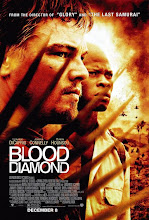In exposing the issue of conflict diamonds, NGO’s have been at the very center of the agenda-setting process and continue to play an important role in monitoring the issue. The two central NGO’s who carried out the movement were Global Witness and Partnership Africa Canada (PAC). Their importance is best exemplified by their 2003 Nobel Peace Prize nomination in 2003. The nomination cites the central role of Global Witness in the movement by quoting Matthew Hart in his book, Diamond: A Journey to the Heart of an Obsession:
“The diamond wars were the secret of the diamond trade until, quite suddenly, they were not. It seemed to happen in an instant, as if a curtain had been ripped aside and there was the diamond business, spattered with blood, sorting through the goods. Its accuser was a little-known group called Global Witness.”
The nomination also cites the initial report put out by Global Witness followed by another report put out by PAC were crucial in exposing the diamond industry to the world. Other written works and activism of the two organizations have contributed to an international awareness of conflict diamonds.
An article by Grant and Taylor describes Global Witness’s first report, “A Rough Trade: The Role of Companies and Governments in the Angolan Conflict,” as being “paramount in exposing…the role of diamonds in funding the Angolan civil war.” (390). After the 1998 Global Witness report, their convictions were strengthened in 2000 by PAC’s report: “The Heart of the Matter: Sierra Leone, Diamonds and Human Security.” These two important reports, followed by some others, have provided substantive knowledge and evidence that backs their claims for change.
Global Witness and PAC partnered together and disseminated their message to a diversified audience. Grant and Taylor refer to their method as “multi-track” diplomacy, which works by building “mixed-actor networks.” (386), but before establishing these networks, they had to frame their issue. Philippe Le Billion exemplifies the framing of conflict diamonds as a new trend in framing transnational issues around consumer rights, which is defined as being “individuals bearing indirect responsibility for the perpetuation of acts of extreme violence against civilians through their consumption practices.” (779). Le Billion describes consumer politics as a new “potent force of change.” (779). This framing became more affective after the events of September 11, when al Qaeda was protecting its money by “sinking its money into gems.” (Grant and Taylor, 388). As soon as terrorism was linked to the diamond industry, the US and other states became interested in bringing the issue to the global agenda.
The successful framing of their issue led to a successful building in several coalitions of NGOs in Europe and the US. In October 1999, a coalition of four European NGOs, entitled “Fatal Transactions” began to send information to media outlets. They sent pamphlets in “jewelers’ boxes” with “cut-glass diamond rings” to newspaper editors (Grant and Taylor, 390). The campaign also came up with several powerful images and phrases, such as “amputation is forever.” In the US, Amnesty International became involved and started disseminating lists of jewelers who sold conflict diamonds. (Grant and Taylor, 391).
On Valentines Day in 2001, a group of 100 NGOs in the United States signed a public letter to the diamond industry urging them to not “let diamonds go the way of fur.” (Grant and Taylor, 391). “The Campaign to Eliminate Conflict Diamonds” was built around the concept of love and romance that the diamond trade markets. NGOs tried to encourage the diamond industry to address the issue so that it did not suffer the consequences of inaction, which could potentially lead to a boycott. (Grant and Taylor, 391). The diamond industry had no choice but to act when states and NGOs began to call for more oversight.
A number of South African countries came together in Kimberley, South Africa (after the passing of the UN Resolution on Conflict Diamonds in 2000) to begin to formulate the Kimberley Process. Global Witness and PAC played integral roles in the process, by proposing plans of action, maintaining pressure and a sense of urgency. (Grant and Taylor, 392). The NGOs success on this issue is largely attributed to their ability to negotiate with the diamond industry, to avoid generalizations, and to understand the complexity of the situation. This is best described in the letter for their Nobel Peace Prize nomination:
“They have succeeded in part because they have avoided polarizing campaign tactics that could have alienated the diamond industry and key governments, whose support is critical to a solution. They understood that, despite the shocking difference between the advertised image of diamonds and the often harsh reality of the trade, a boycott could result in a backlash against a product whose legitimate trade is the backbone of many economies.”
Global Witness, PAC, and Amnesty International are still very involved in overseeing the implementation of The Kimberley Process by offering reports of their findings. They also try to maintain pressure on states and the diamond industry to comply with the international established norm. The NGOs involved in this issue have been central to putting conflict diamonds on the global agenda by framing the issue as a consumer right’s issue and by “multi-tracking” the issue through various actors.
Subscribe to:
Post Comments (Atom)



No comments:
Post a Comment